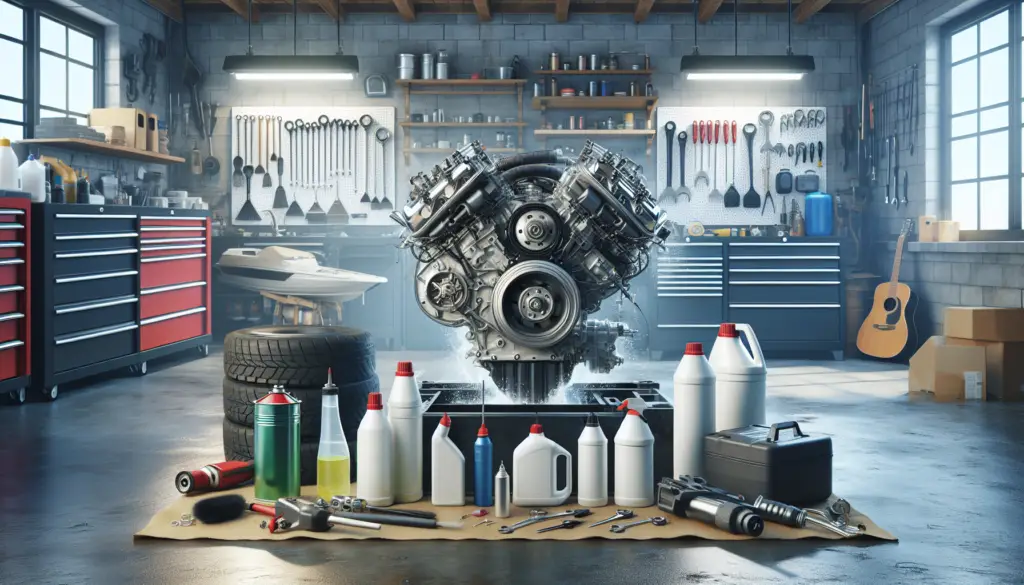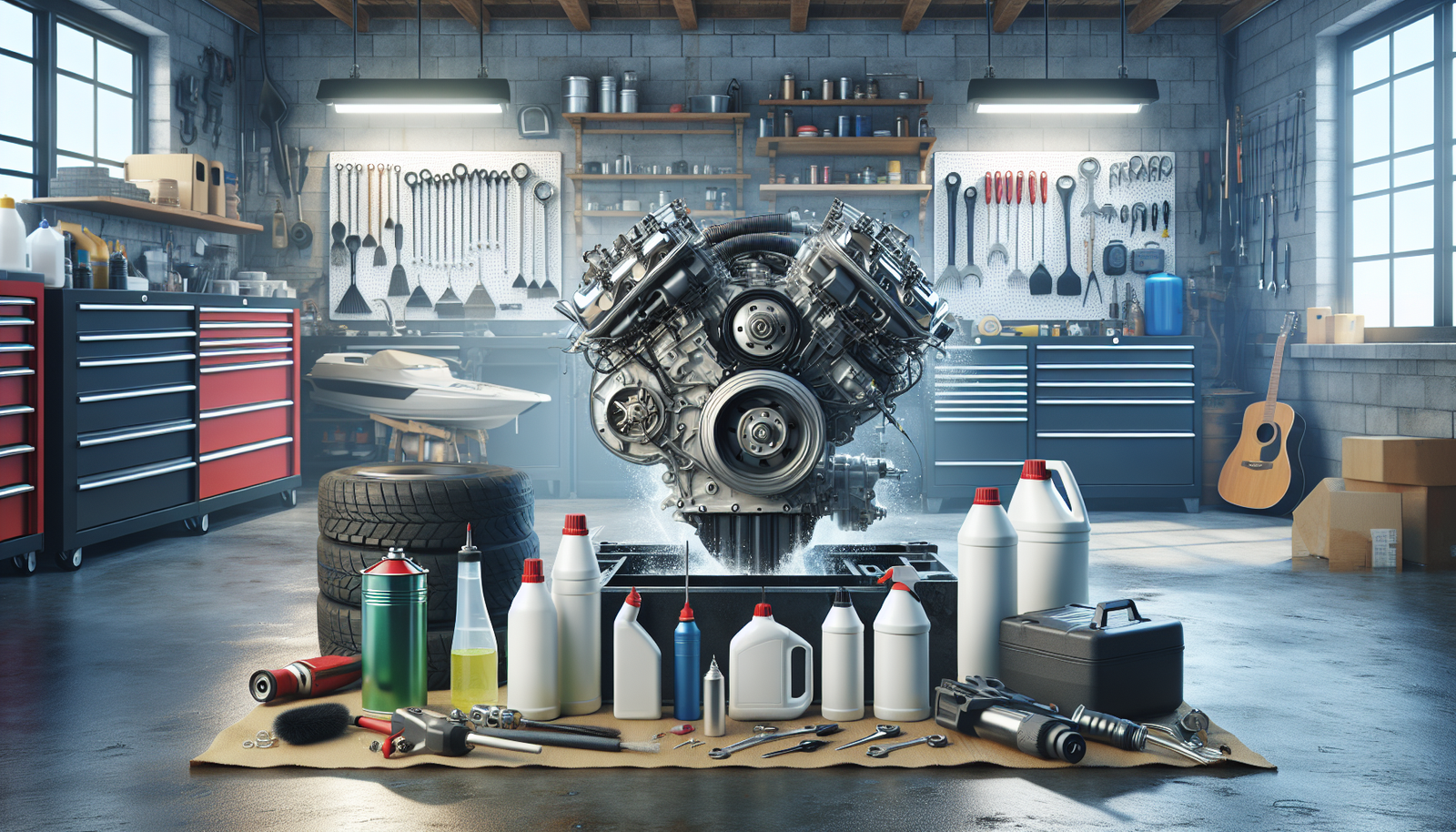As the colder months approach, it’s time to show a little love to your faithful boat engine, ensuring it survives the winter unscathed. This article provides a complete step-by-step guide to boat engine winterization. Trust us, it’s more than just storing your boat away in a garage. Done right, this process will not only prolong the life of your boat engine, but also its performance. So let’s turn that engine off, roll up our sleeves, and get started on the road to boat engine preservation.

Understanding the Importance of Boat Engine Winterization
Boating can be an enjoyable outdoor activity, but the change in weather can put your boat engine at risk. This is why there’s a significant need to understand the crucial process of boat engine winterization. When you correctly execute winterizing your boat, it can increase its longevity and keep it in good health.
Reasons for winterizing your boat engine
One of the main reasons to winterize your boat engine is to protect it from the freezing winter weather. Your engine can sustain damage from the freezing temperatures, especially when water inside the engine expands as it turns into ice. This expansion can lead to cracks and potential damage to the engine compartments, rendering it unusable when the spring season arrives. Taking the time to winterize your boat engine will substantially reduce the risk of any winter damage.
Potential damage resulting from non-winterized engines
Failure to winterize the boat engine can lead to various problems including engine freeze-up, fuel degradation, and battery discharge. These problems can significantly impact your engine’s performance and even lead to the need for costly repairs or replacements. A non-winterized engine is also more likely to have dried up seals which could cause leaks, and rust that can cause corrosion over the winter season.
The cost of neglect: Repair expenses versus winterization costs
The cost of winterizing your boat engine may seem like an unwanted expense, but when compared to the potential repair or replacement costs, it’s worth every penny. Undertaking simple winterization processes can save you from severe financial hit linked with repairing damaged engine parts. In essence, the small cost of winterization significantly outweighs the potential high expenditure on repair costs.
Materials and Equipment Needed for Winterization
Before you start the winterization process, ensure you have the correct tools and materials.
List of necessary winterization materials
Some of the essential materials required for boat winterization include antifreeze, engine oil, fogging oil, battery charger, and a boat cover. It’s wise to have these materials ready before starting the process to ensure you don’t leave anything out.
Basic tools for engine winterization
Besides the materials, you may also need some basic tools such as a wrench, pliers, oil filter wrench, and funnels for oil and antifreeze. Other equipment like an oil extractor pump and a battery tester may also come in handy.
Specification of antifreeze and oil for winterization
When it comes to oils and antifreeze for your boat’s engine, it is advisable to use only marine-grade products. You should also make sure the antifreeze is non-toxic and propylene glycol-based, as it is environmentally friendly and safe to use. As for the oil, it is best to refer to your manufacturer’s guidelines for the appropriate type.
Checking the Manufacturer’s Recommendations
Different boat engines have different specifications and may require different care procedures.
Nature of manufacturer’s guidelines
Most boats come with a manufacturer’s guide, which provides specific instructions on repair, maintenance, and yes, winterization. These guidelines are usually quite detailed and tailor-made to your boat’s model and make.
Applying the recommendations on your boat engine
When winterizing your boat, it’s essential to follow the manufacturer’s recommendations as they know what’s best for the boat’s optimal performance. These instructions give a guide on what to do and what not to do, thus helping you avoid critical mistakes that could harm your boat.
How to find your boat manual and understand its contents
In case you have misplaced your boat manual, you can often find a digital version online by searching for your boat’s make and model. Reading and understanding its contents may often seem technical, but it’s crucial for your boat’s maintenance.

Pre-Winterization: Overall Boat Check and Cleaning
Before you start the winterization process, an overall check and cleaning of the boat is necessary.
Inspecting your boat engine before winterization
Start by inspecting your boat engine carefully. Look for visible signs of damage or wear and tear; these include cracks, leaks, or corroded connections. If you identify any problem, repair it before you begin winterizing your boat.
Routine cleaning procedures pre-winterization
Cleaning your boat helps in removing potential damaging elements like dust and salt which could lead to corrosion during winter storage. Use fresh, clean water, and marine safe cleaning solutions to wash the boat thoroughly. Ensure it is well-dried before you start the winterization process.
Essential checks: Fuel, oil and coolant levels
Checking the fuel, oil, and coolant levels is crucial in ensuring your boat will run smoothly when you’re ready to take it out in the spring. Make sure the fuel tank is full to prevent condensation buildup during storage. The oil and coolant should also be at recommended levels.
Step 1: Flushing the Engine
Flushing the engine eliminates salt, dirt, and other debris from your boat’s cooling system to prevent them from settling within your engine.
How to properly flush your boat engine
With your flush muffs in place and water running, start your engine and let it run for about 15 minutes. This will allow water to penetrate every part of the system. After the flushing process, shutdown the engine and drain the water system.
Why it’s important to flush the engine before winter
Flushing the engine helps to eliminate contaminants that can cause corrosion or damage to your engine over the winter. It’s an essential step in the winterization process to ensure your engine maintains a good health throughout the winter season.
Troubleshooting during engine flush
If you face troubles while flushing your boat engine, such as overheating, it might indicate a serious issue that will need a professional repair. It’s necessary to seek help before proceeding to the next step.
Step 2: Applying Antifreeze
Applying antifreeze is important in preventing freezing damage to your boat’s engine during winter.
Procedure for applying antifreeze to your boat engine
Start by getting a bucket and filling it with your chosen antifreeze. Then, run your engine to warm it up. After that, shut off the freshwater supply, and place the intake hose in the antifreeze bucket. Finally, turn on your engine again and allow the antifreeze to circulate throughout the engine.
Choosing the right antifreeze for your boat
You should ensure that the antifreeze you’re using is propylene-glycol based and safe for marine use. You can consult your manufacturer’s guidelines for specific recommendations.
Potential hazards and precautions when dealing with antifreeze
Antifreeze is toxic in nature; hence you should handle it with care, using gloves and eye protection. Remember not to dump antifreeze on the ground or down a drain, dispose of it in an environmentally friendly manner.
Step 3: Changing Engine Oil
Changing the engine oil is among the most important winterizing tasks for your boat.
The importance of oil change during winterization
Motor oil can accumulate dust, dirt, and other contaminants during the boating season. Changing the oil before storing your boat for the winter will keep the contaminants from settling in and potentially causing internal damages to your engine.
How to change the engine oil of your boat
To change your oil, warm up your engine, and then turn it off. After that, remove the drain plug and let the old oil pour out. While the oil is draining, change the oil filter. Once the oil has fully drained, replace the drain plug and fill the engine with new oil of the right specifications.
Specifying the right oil for your boat engine
Your engine manufacturer will specify the type and weight of oil that is suitable for your boat’s engine. Generally, you should use high-quality marine engine oil to ensure the best protection for your boat.
Step 4: Battery Removal and Care
Proper care and storage of your boat’s battery during winter is necessary to ensure its longevity.
How to safely remove boat engine battery
To safely remove the battery, start by turning off all electrical loads. Disconnect the negative cable first, then the positive cable. Remember to remove any corrosion and dirt on the terminals.
Proper storage for boat batteries during winter
During winter, store the battery in a cool, dry place off the floor. Maintain a full battery charge by using a trickle charger. This will keep the battery from freezing and ensure it’s ready for use in the spring.
Battery maintenance procedures
Maintenance during storage involves charging the battery periodically to ensure its durability. Checking the water levels and cleaning the battery terminals can also help maintain its efficiency.
Step 5: Protecting the Engine and Components
Taking steps to protect your engine from the harsh winter conditions can save you from potential disappointments.
Usage of fogging oil in engine protection
Fogging oil helps to safeguard the internal parts of your engine, which can rust over time if not properly protected. By spraying fogging oil into the carburetor and spark plug holes, you can ensure that the internal parts of your engine are well lubricated and protected throughout the winter.
Covering the engine: Choices and how-to
Covering the engine is vital to protect it from dust, debris, and moisture. Ensure to use a cover that is water-resistant and fits snuggly around your engine.
Additional preventive measures: Lubrication and corrosion prevention
Make sure to lubricate all moving parts of the boat. Apply a thin layer of grease or petroleum jelly to metallic parts to prevent corrosion.
Final Checks Before Storing the Boat
Before you store your boat for winter, ensure everything is in top order.
Ensuring safety by re-checking the boat
Perform a final walk-around to check everything once more. Ensure all the plugs are replaced, antifreeze levels are appropriately maintained, and the boat is cleaned and dried properly.
Proper storage areas for winterized boats
Store your boat in a sheltered, dry place to protect it from harsh weather conditions. If outdoor storage is your only option, consider investing in a high-quality boat cover.
Understanding the do’s and don’ts of winter boat storage
Lastly, remember to store your boat properly. Do elevate the bow so any water that gets into the boat will flow to the back and out the drainage hole. Don’t close all the ventilation ports or windows, as mildew can build up in a tightly sealed boat.
In conclusion, winterizing your boat engine is crucial to maintain its longevity. Take time to acquire the right materials, follow the manufacturers guideline and implement the appropriate steps, to ensure that your boat will be ready to hit the waves once the winter season passes. Be aware of the costs associated with neglecting this duty, and understand that the investment of time and a slight expense now will ensure many happy returns out on the water in the future.

